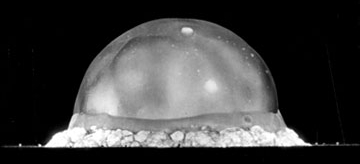This is one of a series of articles being produced by Aberdeen and District Campaign for Nuclear Disarmament (CND). You can read further articles in both past and future editions of Aberdeen Voice. With thanks to Jonathan Russell.
Approximately 35 percent of the energy from a nuclear explosion is an intense burst of thermal energy.
The effects are similar to the effect of a two-second flash from an enormous sun-lamp.
- Initially, most of the energy goes into heating the bomb materials and the air in the vicinity of the blast.
- Temperatures of a nuclear explosion reach those of the interior of the sun, about 100,000,000 Celsius.
- Two pulses of thermal radiation emerge from the fire ball that is created. The first pulse, lasting a tenth of a second, consists of radiation in the ultra-violet region. The second pulse lasts for several seconds. It carries 99 per cent of the total thermal radiation. It is this radiation which causes the skin burns and eye injuries suffered by exposed individuals.
- It also causes all combustible materials to break into flames, the amount of damage greater in clear air than cloud. The fireball itself – an extremely hot and highly luminous spherical mass of air and gaseous weapon residues, (see article on blast effects) occurs within less than one-millionth of one second of the weapon’s detonation, the fireball rising like a hot air balloon.
Immediately after its formation, the fireball begins to grow in size engulfing the surrounding air. This growth is accompanied by a decrease in temperature (because of the increase in size).
As explained, the fireball rises like a hot air balloon. Within seven tenths of one millisecond from detonation, the fireball from a one megaton weapon is about 440 feet across, and this increases to a maximum size of 5,700 feet across in 10 seconds.
It is then rising at a rate of 250 feet per second.
After a minute, the fireball has cooled to such an extent that it no longer emits visible radiation. It has risen roughly 4.5 miles from the point where it burst.
As the fireball increases in size and cools the vapour condenses to form a mushroom cloud containing solid particles of the weapon’s debris, as well as many small drops of water derived from air sucked into the rising fireball. Added to this, winds suck in dirt and debris from the earth.
Flash burns are one of the serious consequences of nuclear explosions. They result from the absorption of radiant energy by the exposed skin.


